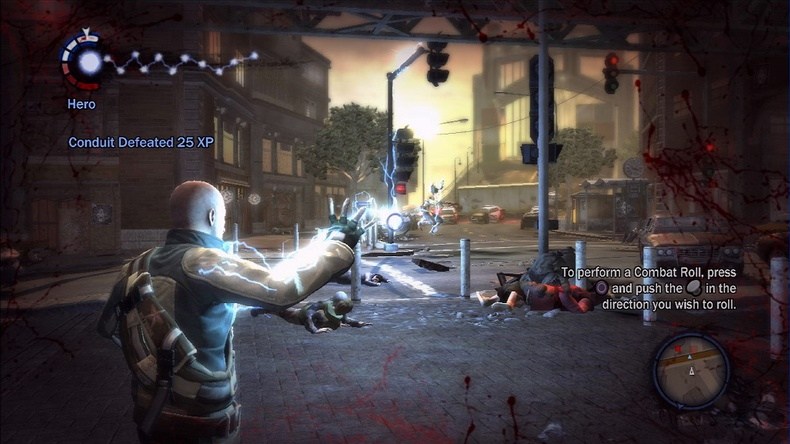
The box reads “a massive explosion rips through six blocks of Empire City, killing everyone in its path…except you. You now wield extraordinary powers. Will you use them to save what’s left or destroy it all?” That’s a really terse summary of inFamous, the latest game from Sucker Punch, the developers of the Sly Cooper games for the PlayStation 2.
The “you” in inFamous is Cole McGrath, a bike courier who was trapped in the center of the explosion. The powers he receives as a result of the blast are electrical in nature. Cole initially can shoot lightning bolts from his finger tips. He also can withstand large amounts of damage, even being able to fall from high places without being injured. As the game progresses, the intensity and precision of his electric abilities can be modified through the experience points he receives by incapacitating enemies, healing pedestrians, and completing side missions among other things. Eventually, Cole gains the ability to throw stun grenades of energy, command lightning storms, shield himself from harm, and project a Force-like shock-wave from his hands.
Cole is also fairly acrobatic, with excellent climbing and jumping skills. This makes navigating Empire City’s three “districts” a lot more fun. Cole can run across rooftops, jump, or grind across power and rail lines to get from one side of the game’s world to the other. Or he can walk. It’s your choice.
The backstory of inFamous is an amalgam of elements from post-apocalyptic movies and comic-books. The explosion that creates Cole is, of course, not a random accident. There are nefarious forces at work in Empire City, which itself is quarantined from the rest of the United States due to a mysterious plague. Soon after Cole receives his powers, he is contacted by various people who guide him to perform missions in the city. By finishing these quests and tasks, Cole begins to discover and understand his powers’ origin and their place in the overall scheme of things.
inFamous gives the player the ability to follow a good path or an evil path. Cole’s missions, powers, and his treatment by the other citizens of Empire City are dependent on which path the player chooses. Each of the three island districts of Empire City – the Historic District, the Warren, and the Neon District — will change in appearance as Cole restores power and defends the inhabitants from the gangs that terrorize each area. (I played through the good path of the game.)
The game controls quite well, with most of Cole’s basic electric powers requiring the player to hold down the L1 button and press another button on the PS3’s controller. Some advanced powers require a combination of d-pad and button action but things never get too complicated.
Cole can recharge his energy meter by draining electricity from power sources scattered around the city. These range from utility poles to car batteries and, understandably, each provides a varying amount of energy for Cole to use. When Cole is injured, blood begins to splatter across the screen and the picture begins to lose color. Cole’s health will regenerate over time but the player can accelerate the process by draining energy from the aforementioned power sources.
A karma meter shows where Cole’s actions rank him between pure good and pure evil. Reaching the extreme of total good or total evil enables Cole to activate unlimited energy for a short period of time. This karma also determines the treatment Cole receives from the other residents of Empire City. In my play-through the good path of the game, Cole’s presence in the city was initially greeted with indifference and heckling. As I began to make progress in ridding the streets of the gangs and thugs that plagued the city, and my karma meter approached “hero” status, the pedestrians would stop to take pictures of Cole and shout encouragement. Eventually I began to hear comments like, “Cole, I want your baby” and “Call me!” from the ladies of Empire City. It’s oddly encouraging to see your actions have an effect on the city.
Climbing the many buildings and structures in the game is aided by Cole’s ability to stick to many types of surface areas without falling off. This “stickiness” can sometimes be frustrating in timed side missions when you’re trying to run or jump quickly from one area to another and Cole suddenly grabs onto a ledge or window sill, throwing your timing off completely. However, in most cases, the stickiness provides shelter from frustration rather than causing it by making it nearly impossible to accidentally fall off a ledge or wire.
Playing through inFamous is challenging but never overly frustrating. Many longer missions have checkpoints contained within so that, even if Cole is killed midway through a quest, you don’t have to restart from the very beginning. Sucker Punch did an excellent job balancing the difficulty and complexity of the quests in the game. I never once felt like throwing my controller through my TV screen. I did, however, lose all track of time on several occasions. More than once, I noticed the the light of the new day’s rising sun in what seemed like minutes after starting a gaming session at around midnight.
inFamous is exclusive to the PlayStation 3 and, while I don’t think it could be considered a true showcase of the system’s power, I think it’s good enough to be considered a system-selling game. inFamous is on my very short list of games worthy of being considered for “game of the year” for 2009.
10 out of 10.

